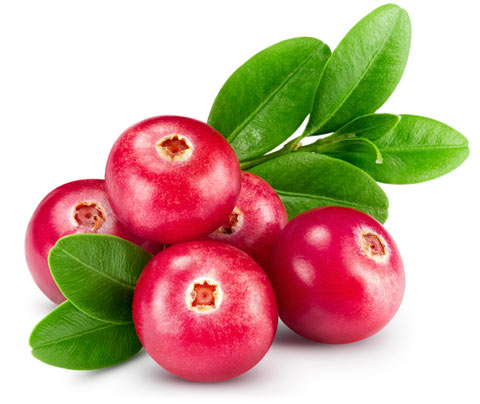Cranberry's Anticancer Benefits

Fun Facts:
Native to the United States and Canada, cranberries first became a commercially produced food after the Revolutionary War. Commercial cranberry bogs now cover 40,000 acres of farmland in the northern U.S. The growing process typically includes flooding the bogs and harvesting the fruit as it is loosened from the plant and floats to the top. (i.1)
Cranberries (Vaccinium macrocarpon) were used in traditional Native American medicines, and today have demonstrated a long list of health benefits. Cranberries are rich in vitamin C and fiber, but also contain antioxidant phytonutrients and flavonoids such as proanthocyanidins and anthocyanidins (the deep-colored pigments give cranberries their rich red color). (i.1, 5, 52)
One of the most commonly known uses of cranberry is as a home remedy for urinary tract infections. In fact, cranberries have been proven in clinical trials to contain properties that inhibit bacteria and prevent it from sticking to cells within the body. These protective properties have been found to prohibit certain bacteria in the urinary tract, as well as the digestive tract and may even offer protection for the teeth and gums. (i.1)
Cranberry's suggested cancer fighting abilities are at least in part due to the antioxidant power it gets from high levels of anthocyanidins. Compared to 19 other fruits, cranberry has the highest levels of these powerful pigments — especially when fresh. Unsweetened cranberry juice is one of the most potent antioxidant-containing juices, behind only grape juice and cloudy apple juice in one study. (i.2, 52)
Nutritional Content
Raw cranberry is high in many vital nutrients, but even the familiar sweet condiment that accompanies Thanksgiving dinner in the United States offers nutritional value: (i.57)
| CRANBERRY | ||
|---|---|---|
| NUTRIENT | WHOLE, RAW |
SAUCE, SWEETENED |
| Calories |
37 calories/serving |
86.07 calories |
| Protein | 0.37 g | 0.11 g |
| Sugars | 3.84 g | 21.60 g |
| Fiber | 4.37 g | 0.57 g |
| Beta carotene | 34.2 mcg | 14.25 mcg |
| Calcium | 7.60 mg | 2.28 mg |
| Folate | .95 mcg | 0.57 mcg |
| Glutamic acid | 0.14 g | --- |
| Iron | 0.24 mg | 0.13 mg |
| Lutein & Zeaxanthin | 86.45 mcg | 35.91 mcg |
| Magnesium | 5.70 mg | 1.71 mg |
| Manganese | 0.34 mg | 0.03 mg |
| Niacin | 0.10 mg | 0.06 mg |
| Potassium | 80.75 mg | 14.82 mg |
| Selenium | 0.10 mcg | 0.17 mcg |
| Vitamin A | 57.00 IU | 23.94 IU |
|
Vitamin B5 |
0.28 mg | --- |
| Vitamin C | 12.64 mg | 1.14 mg |
|
Vitamin E |
1.18 mg |
0.47 |
| Zinc | 0.10 mg | 0.03 mg |
Evidence of Cancer-Fighting Benefits
Research indicates that cranberries can help fight cancer cells. Some of the specific phytochemicals cranberries contain that have been shown in studies to have chemopreventive properties include quercetin compounds and ursolic acid. The combination of anthocyanins, flavonols, and proanthocyanidins in cranberries has been shown to inhibit the following types of cancer cell lines: (i.1, 5, 60)
- Brain cancer (glioblastoma)
- Breast cancer
- Colon cancer
- Leukemia
- Lung cancer
- Ovarian cancer
- Prostate cancer
In addition, in animal studies using transplanted breast cancer, colon, nervous system, and lymphoma cancer cells, injections of cranberry extracts reduced the incidence, size, and spread of tumors. Other research involving dietary intake of cranberry extracts showed that cranberry significantly reduced the size and number of bladder tumor lesions. (i.60)
How Do Cranberries Stop Cancer Cells?
Lab and animal studies involving cranberry extracts suggest that in addition to cranberry's potent antioxidant protection against cancer-causing free radicals, it appears to exert the following antitumor effects: (i.60)
- Anti-inflammatory influences.
- Induce apoptosis, or natural cell death, in cancer cells.
- Inhibit cancer cells from dividing and proliferating, slowing down the development of tumors.
- Lower production of molecules that prevent cancer cells from dying
- Significantly reduce the activity of matrix metalloproteinases, enzymes that help cancer cells spread and metastasize.
Adding Cranberries to Your Diet
Cranberry juice may be sweetened or unsweetened, and care should be taken to avoid varieties that have been heavily sweetened with corn syrup or sugar. These added sweeteners can cancel out health benefits. Because most people will find unsweetened juice bitter or extremely tart, it's helpful to mix equal parts of sweeter varieties of juice, such as apple, or blend your own fresh fruits (e.g., some grapes, an orange, and a couple of apples) and add in a dash of honey. A teaspoon or so of a natural zero-calorie sweetener (such as stevia) can help take the tart edge off too. (i.1, 5, 52)
You can also try drying cranberries if you have a dehydrator. They make for a great healthy snack and can be mixed with nuts and other dried fruits for a colorful trail mix, or used like raisins in baking. Or toss in some fresh cranberries to your salad with a little olive oil for a flavorful, healthy surprise. (i.52)
Choosing and Storing Cranberries
Fresh or store-bought cranberries should be plump and bright in color and are best stored in your refrigerator's crisper. They can be refrigerated for up to four weeks and frozen for up to six months. (i.1)
The best way to freeze cranberries is to first freeze them spread out on a cookie sheet and then transfer to a freezer bag. Defrosted, the cranberries will be soft and should be used quickly. (i.1, 52)



